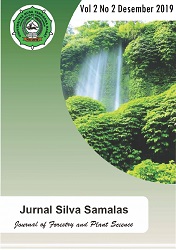ORGANIC FERTILIZATIONTO INCREASE YIELD OF SOYBEAN VAR. ANJASMORO INTERCROPPED WITH VARIOUS VARIETIES OF RED RICE UNDER AEROBIC IRRIGATION SYSTEM
DOI:
https://doi.org/10.33394/jss.v3i1.3677Abstract
References
Aryana, I.G.P.M., and W. Wangiyana, 2016. Yield Performance and Adaptation of Promising Amphibious Red Rice Lines on Six Growing Environments in Lombok, Indonesia. Agrivita, 38(1): 40-46.
Bouman, B.A.M. 2001. Water-efficient management strategies in rice production. International Rice Research Notes, 26(2): 17-22.
Dulur, N.W.D., W. Wangiyana, N. Farida, and A. Wiresyamsi. 2016. Yield of Two Red Rice Genotypes between Flooded and Aerobic Rice Systems Intercropped With Soybean. IOSR Journal of Agriculture and Veterinary Science, 9(12, ver.II): 01-06. http://iosrjournals.org/iosr-javs/papers/Vol9-Issue12/Version-2/A12020106.pdf.
Mayasari, D. dan W. Wangiyana. 2018. Pertumbuhan dan Hasil Berbagai Varietas Kacang Hijau antara Sistem Monocrop dan Penanaman Bersama Padi Beras Merah pada Sistem Irigasi Aerobik. Agroteksos, 28(2): 42 – 48.
Prasad, R., 2011. Aerobic Rice Systems. Advances in Agronomy, 111: 207-247. (DOI: http://dx.doi.org/10.1016/B978-0-12-387689-8.00003-5).
Prasad, R.B., and R.M. Brook. 2005. Effect of varying maize densities on intercropped maize and soybean in Nepal. Experimental Agriculture, 41: 365 – 382.
Riley, J. 2001. Presentation of statistical analyses. Experimental Agriculture, 37: 115 - 123.
Turmudi, E. 2002. Kajian pertumbuhan dan hasil tanaman dalam sistem tumpangsari jagung dengan empat kultivar kedelai pada berbagai waktu tanam. Jurnal Ilmu-Ilmu Pertanian Indonesia, 4(2): 89-96.
Wangiyana, W., I.G.P.M. Aryana, and N.W.D. Dulur. 2019. Increasing Yield Components of Several Promising Lines of Red Rice through Application of Mycorrhiza Bio-Fertilizer and Additive Intercropping with Soybean in Aerobic Irrigation System. International Journal of Environment, Agriculture and Biotechnology, 4(5): 1619-1624.
Wangiyana, W., I.G.P.M. Aryana, I.G.E. Gunartha, and N.W.D. Dulur. 2018. Tumpangsari dengan Kedelai dan Inokulasi dengan Mikoriza Arbuskular untuk Meningkatkan Produksi Malai pada Berbagai Galur Harapan Padi Gogo dan Ampibi Beras Merah pada Sistem Aerobik. Prosiding Sem. Nas. Lingkungan Lahan Basah, 3(2): 388-393. https://snllb.ulm.ac.id/prosiding/ index.php/snllb-lit/article/view/86/84.



